There has been a lot of gossips all over the internet when there is a matter of Jeep CJ5 Vs CJ7.
There are many of the differences between these two models which we are going to talk about in this post. The CJ5 Jeep is a version of the military jeep during the Korean War and the World War ll era.
This model is the most enduring marque which was used for both city driving as well as for off-road.
On the other hand, the CJ7 Jeep was introduced in the year 1976 and has some of the unique features that include steel doors, a molding plastic top, automatic transmission, and much more.
Jeep CJ5 VS CJ7 Historical Background
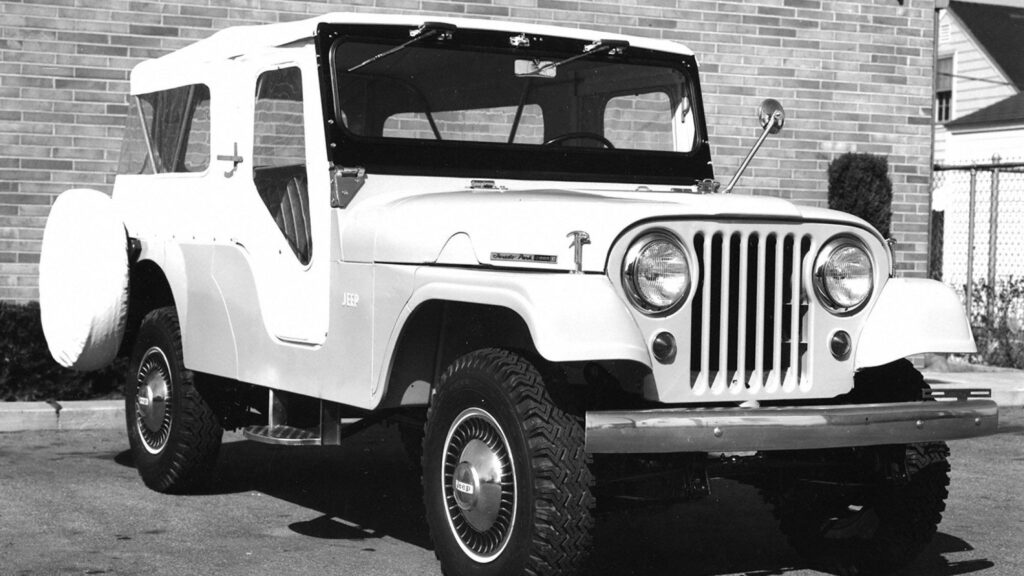
Let us find out everything about these two super well-known models of Jeep. We will check out the short history of both of these models and will also see differences.
Jeep CJ5
In June 1940, shortly after the outbreak of World War II, a contest was launched in the United States to design a combat vehicle. Bantam Motor Company and Willys-Overland, which presents a quad, are the companies that come to the call and Ford joins.
Willys is the winner and the result is the final 1941 MB (although everyone knows it as Jeep), of which 650,000 units are manufactured during the contest.
After the conflict ended in 1946, Willys adapted the Jeep for civilian use and the first model was the CJ-2A (Civil Jeep 2A). Later Station Wagon AS appears and in 1948 the CJ-3A and Jeepster.
Willys-Overland is bought by Henry J. Kaiser and, under the name of Kaiser Willys Motors Inc., exclusively develops Jeep projects, a name that was registered as a brand in 1950.
The first result is the CJ-3B as well as, about the MB, this new model provides modifications to the bodywork. It remains in production for 15 years. But the real change comes in late 1954, with the legendary CJ-5.
Its greater wheelbase allows more interior space and features suspensions that provide greater comfort. It soon captures the attention of new fans of off-road activities and, even with important modifications, it resists until the 80s.
Kaiser Jeep Corporation is taken over by American Motors Corp., which already produces 660 cars a day at the end of the decade (in 1974, AMC manufactured 175 Jeep a day, giving an idea of the expansion of 4x4s).
The company enhances the CJ-5 and CJ-6 with stronger axles, more powerful brakes, and wider tires, and presents the Renegade, a limited edition of the CJ-5.
In 1973 comes the Quadra-Trac system, the first automatic permanent all-wheel drive device. A year later the Cherokee was born, one of the most successful SUVs in the world.
Although initially displaying an aesthetic similar to that of the Wagoneer, it soon takes on its own identity. The CJ-7 was introduced in 1976, with a plastic or canvas roof and steel doors.
The decade ends with the launch of the Wagoneer Limited: for the first time, the level of luxury of a 4×4 is comparable to that of a passenger car.
Jeep CJ7
The Jeep CJ7 arrives in 1976 to replace the latest versions of the CJ5 and CJ6. A classic cut SUV and robust appearance that follows the line of what the range had been offering.
It grows in size and offers greater interior habitability, also improving its stability.
One of the most important innovations in the Jeep CJ7 was the possibility of mounting a 5-speed manual gearbox and, for the first time, a 3-speed automatic. It had different engine options.
The CJ Family, Life After the War
CJs were a range of vehicles from the manufacturer Jeep that was in production from 1945 to 1986. They were characterized by being compact, open-body SUVs.
The acronym CJ refers to Civil Jeep and is that they began to be manufactured just after the Second World War, differing from the one used during the conflict, the Willys MB.
Among the entire CJ range, the CJ7 is probably the most successful and remembered, remaining on the market from 1976 to 1986 and with a total of 380,000 units manufactured.
The Jeep CJs went as far as the CJ10 nomenclature, although some of them had more versions available. After the CJ10, Jeep decided to replace its range with the Jeep Wrangler, in 1986.
Evolution of the Model
In chronological order, and only by way of example to frame the imminent article on the unit I have in the garage, the effective civil evolution of the protagonist of these lines was as follows.
CJ-2A (1945-1949), CJ-3A (49 -53), CJ-3B (53-present, distinguishable mainly because its hood is higher, to accommodate the new Hurricane engine: another 2.2 liters, although this time 75 HP).
Until what we could say that they are the classic ones, the genuine ones; that is, the models that first come to mind when we think of Jeep.
In 1954, the new CJ-5 is presented, in the image of the one used during the recently ended Korean War, which would be produced until 1983. Then came the CJ-7 (1976-86), with important structural and mechanical changes but with a very similar exterior appearance.
And both increasingly powerful thanks to 6 and 8 cylinder thrusters introduced by the brands that Willys were buying: Kaiser Motors, American Motor Company (AMC), and, finally, Chrysler.
CJ5 VS CJ7: Best Features & Detailed Review
Jeep CJ5
In the year 1955, Kaiser Introduced the CJ-5 model which was based on the 1951 M-38A1. CJ5 is improved with the engine, traction, and transmission.
A CJ-5 is derived directly from the Willys Jeep, the off-road vehicle. The Americans had developed for the Second World War in 1940, and which the entire vehicle type of off-road vehicles in the Car format justified.
Launched Year
The CJ-5 was launched in 1955 as a civilian version of the Willys Jeep and was built until 1983. The CJ-5 was launched in 1955 as a civilian version – CJ stands for Civilian Jeep – of the military M38A1, a late evolution of the Willys.
It was built as the CJ-5 up to 1983 and still holds the record for the longest-built jeep model. Our copy is from 1973 and is something special because it was the first year in which customers received the CJ-5 with a V8 engine on request.
The 5.0-liter 8-cylinder normally powered the sedans and coupes of the small US automaker American Motors Company (AMC), which bought the Jeep brand in 1970 from the even smaller US manufacturer Kaiser.
The V8 cost a few dollars extra compared to the six-cylinder and made it clear where the journey of the Jeep brand under the direction of AMC should go: away from the image of the war machine and commercial vehicle, towards leisure and adventure driving for private buyers.
The CJ-5 is Somehow not Made for the Road
The CJ-5 is notorious for being difficult to keep on the road even at normal highway speeds. It likes to blow out as soon as the rear axle gets a kick through a pothole or a bump.
Then it turns across at lightning speed, swings up, and can hardly be caught again with the mega-indirect steering. In the worst case, it even rolls over – and does not offer any protection, because the windshield frame does not withstand a roll sideways.
That’s why drivers of a CJ-5 prefer to drive slowly on the road. On the other hand, the explosive construction allows top performance in the field.
For off-road trials that had their heyday in the 1980s, a higher-level CJ-5 V8 retrofitted with differential locks was considered an almost unbeatable competitor.
Other Most Important Details
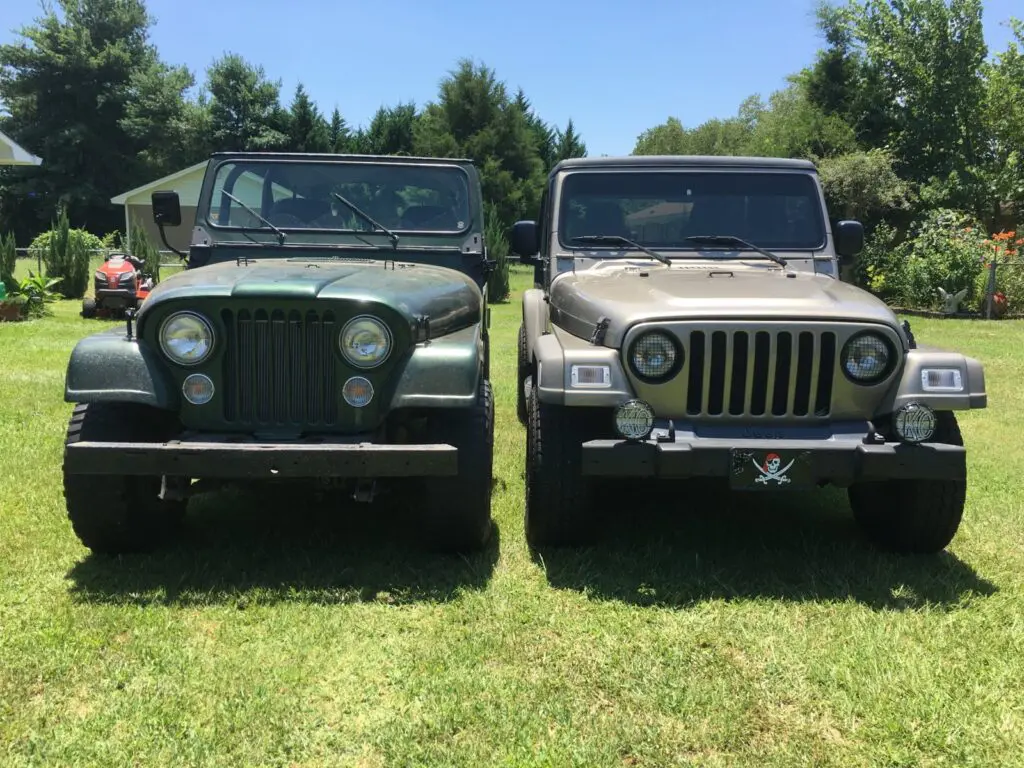
In 1976 there was a facelift, in the course of which the driver’s cab and the frame were slightly revised. A further revision was made to the windshield frame.
At the beginning of the 1980s, a special version of the Jeep CJ 5 called Hurricane was available, which was equipped with a four-cylinder in-line engine of the type GM-Iron-Duke.
Also, the Jeep CJ5 was available with a 3.7-liter diesel engine. The empty weight of the car was 1990 kg with a wheelbase of 2057 or 2121 mm. The vehicle had a total length of 3250 mm, a width of 1480 mm, and a height of 1890 mm.
Between 1972 and 1983 the Jeep CJ 5 was also available as a Renegade model. This was equipped with a V8 engine that had a displacement of 4981 cm3. Also, the special model was equipped with alloy wheels and a limited-slip differential.
After more than 30 years of production, the production of the Jeep CJ 5 was finally stopped in 1983.
Engine
- Engine type: Piston
- Engine size in L: 2.2 L
- Cylinders: 4
- Engine size in CC: 2199 CC
- Induction: Aspirated
Drivetrain and Transmission
- Gears: 3
- The generic type of gears: Manual
- Drive: 4×4
- Gear type: Manual
- Gear location: Floor
Fuel
- Fuel type: Petrol
- Delivery method: Mechanical
- CO2 Combined Emission: 379 g/km
- Fuel Combined Consumption: 16 L/100 km
- Fuel Delivery: Carburettor Single
Jeep CJ7
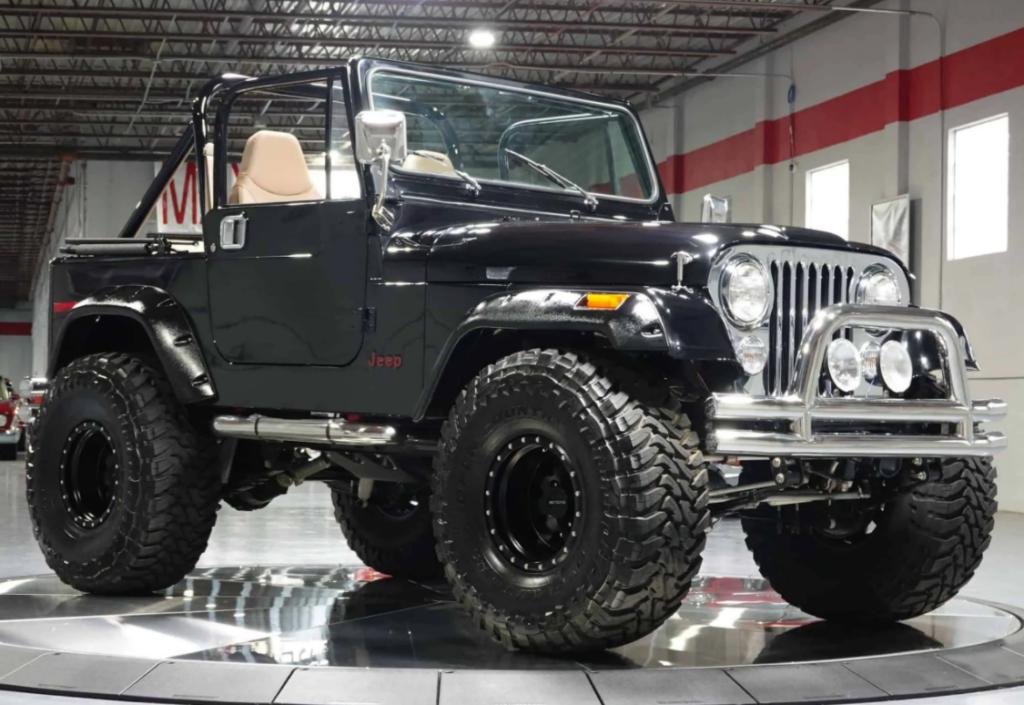
Jeep CJ17 is the pure north American TT made between 1976 and 1986. The CJ-7 was born in 1977, ending the CJ-5’s 30 years of production.
It did, the truth, without too much imagination, imposing a conservatism improper than other contemporary creations of the American Motor Corporation (owner at the time of Jeep), such as the Gremlin, Matador, or Pacer passenger cars.
Three decades later, the CJ-7 wanted to be a safe value and provide the improvements that its customers demanded without losing its robustness, its off-road capabilities, or its manageability.
Let us find out features and other details of this Jeep model
Specialties
The special series of the CJ-7 were very popular and “forced” to develop new equipment, such as air conditioning (you can see the additional module with the air conditioning nozzles in the image on the right), the automatic transmission, or the column of the tilting direction.
In the 70s, a quality car had to have good instrumentation. The rev counter was optional, but there was a voltmeter, a lubricant barometer, and a coolant thermometer.
Gasoline Engines
Under the hood of a CJ-7, we can find four different AMC gasoline engines (2.4, 3.8, 4.2, or 5.0), another from GM (2.5), and even a 2.4-liter Isuzu diesel.
Motor
Longitudinal front, 8-cylinder V, 4,982 cm3 (95.3×87.3 mm). Power: 126 CV. at 3,600 r.p.m. Torque: 296 Nm at 2,000 r.p.m. Distribution 2 valves per cylinder, OHV, side camshafts.
Transmission
Traction: permanent rear, the manual connection of the front, and reduction gear.
Gearbox: Three-speed automatic (torque converter).
Direction
Type: Ball recirculation, assisted (opt.).
Turning diameter: 12.50 meters.
Chassis
Type: Stringers and crossbars.
Suspension of the. / rear: Rigid axle with longitudinal leaf springs front and rear.
Brakes
Front / Rear: Drums / Drums.
Assistance: Mechanical delivery man.
Dimensions
Length / width / height: 3,760 / 1,740 / 1,720 mm. Battle: 2,370 mm. Front / rear track: 1,308 / 1,270 mm. Weight: 1,228 kg. Dep .: 57 liters Trunk: N.D.
Wheel
Tires: Steel, N.D.
Consumption and CO2
Maximum speed: 123 km / h; 0-100 km / h: 13.0 s. Consumption: 11.3 l / 100 km Autonomy: 504 km. CO2 emissions: N.D.
Equipment
Series: Front seats with headrests, complete spare wheel. Optional: Automatic transmission, rear differential lock, winch, rev counter, chrome bumper, tow hook, and much more.
Powertrain and Transmission Options Available
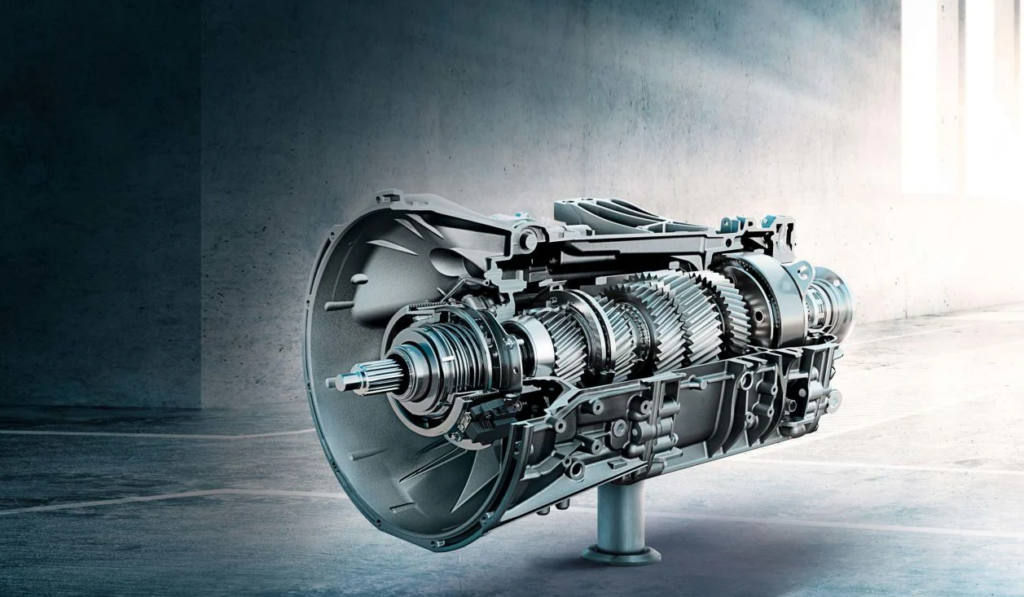
This SUV was available during its commercial life in six different motorization options, five of them gasoline and one diesel. Among the first, four of them were developed by AMC, while the rest was in charge of GM.
The only diesel engine available for the Jeep CJ7 was developed by the manufacturer Isuzu.
Among the AMC engines, you could choose between displacements of 2.4, 3.8, 4.2, and up to 5 liters, while that of GM was a 2.5. For its part, the Isuzu diesel block had 2.4 liters.
They were divided into 4-cylinder options, with powers of 83 and 87 HP, 6 cylinders with 100 and 115 HP, and up to 8 cylinders in V, with powers of 150, 175, and up to 195 HP.
Different Ranges and Standard Equipment
During all the years it was in production, the Jeep CJ7 had various lines of equipment available, as well as series and special versions. Among the most recognized is the Renegade series, in production during all the years the CJ7 was marketed.
This is also joined by the Golden Eagle, in production until 1980, the same year the Golden Hawk was launched. For its part, the Laredo was marketed from 1980 to 1986, while the Limited did so only during the years 1982 and 1983.
Finally, the Jamboree Edition range, which was launched in 1983.
When it came to the standard equipment available on the Jeep CJ7, it was pretty stark, featuring a spare wheel, front seats with headrests, an instrument panel with different watches, a radio, a detachable top, and a roll bar.
Main Advantages of Jeep CJ7
- The Jeep CJ7 has a very recognizable exterior design, with a purely military image, even though this range was intended for civil use.
- Moving inside the vehicle, the CJ7 had only the basics, and instrumentation panel (in which the rev counter was optional), radio and glove box.
- The popular North American SUV had a rear row of seats, but it was not comfortable enough to accommodate two more passengers.
- Its off-road skills are outstanding, especially considering that it derives from a 4×4 version used in war. It can with any type of terrain.
- The range of motorization of the CJ7 was wide and varied, with powers between 83 and 195 hp.
Difference Between Jeep CJ5 and Jeep CJ7: Jeep CJ5 VS CJ7
When we talk about determining the difference between both models Jeep CJ5 and Jeep CJ7, there has been a lot of buzz on the internet. Some differences are more personal, like “better”.
These ideas are trying to address stability, strength, driving, and other applications.
Size
The CJ7 is larger than the Jeep CJ5. The shortened CJ5 even expanded at the same time, reaching approximately 2 inches of wheelbase. This increases the Jeep CJ5’s wheelbase measurements to 83 inches.
Automatic Transmission
The CJ5 has never been manufactured with an automatic transmission, but it has a chronic standard with a manual transmission. However, it is possible to find homemade models that automatically change the manual transmission.
It is still tough to find one of these on the market. If you need a gun, you will be more successful with the CJ7. In 1983, the CJ7 version was updated to include acceleration.
Therefore, you can easily find that there is a difference of up to 10 inches between the CJ5 and CJ7.
Frame
The slight addition of weight and the longer wheelbase kept the improved CJ7 on the road when cornering. It also gave the CJ7 the ability to accommodate an automatic transmission, the first in the CJ series.
AMC also redesigned the CJ7’s chassis which feature twin parallel cesarean lanes to stabilize the rear. The automaker also hardened the springs and mounted them, along with the shock absorbers, closer to the edge of the frame to improve handling.
Under-hood
CJ5 featured moderate power. Torque, not all horsepower output, is important to a vehicle Willys and Kaiser market as an off-road vehicle. Early thrusters include a four-cylinder hurricane engine with a modest 7.4-to-1 compression ratio.
In 1965, the CJ5 featured the 160-horsepower, 225-cubic-inch Dauntless V-6 engine with a torque of 235 pound-feet. The CJ5 begins to be V-8 in 1972, which displaced 304 cubic centimeters and generates 150 horsepower and 245 pound-feet of torque.
Buyers can also order the CJ5 with the 232-cubic-inch base on the six-cylinder line or 258 V-6. The 151 cubic inches inline 4-cylinder Iron Duke appeared in 1980 in response to the 1970s gasoline shortage.
CJ7 shared the same engines with the CJ5 except for the Dauntless V-6. The CJ7 was also available with a 145 cubic inch inline four-cylinder C240 Diesel Isuzu engine.
Wheel Size
In most cases, you can count on the difference in sizes, although there are always exceptions on the market. The CJ5 offers an 83-inch wheelbase, 139-inches long, and 69-inches wide.
The CJ 7 is typically 93 inches, 149 inches long, and 69 inches wide, and is well known on the market today.
Cylinders
When we talk about the cylinders in both models, CJ-5 comes with 6 cylinders while CJ-7 has 4 cylinders.
Summary
- CJ7 is more general.
- CJ7 is easier to find on the market.
- CJ7 offers a manual and automatic transmission.
- The CJ7 has a larger travel area, as well as larger door frames, traffic jams, and other basic building features.
What Suits Me?
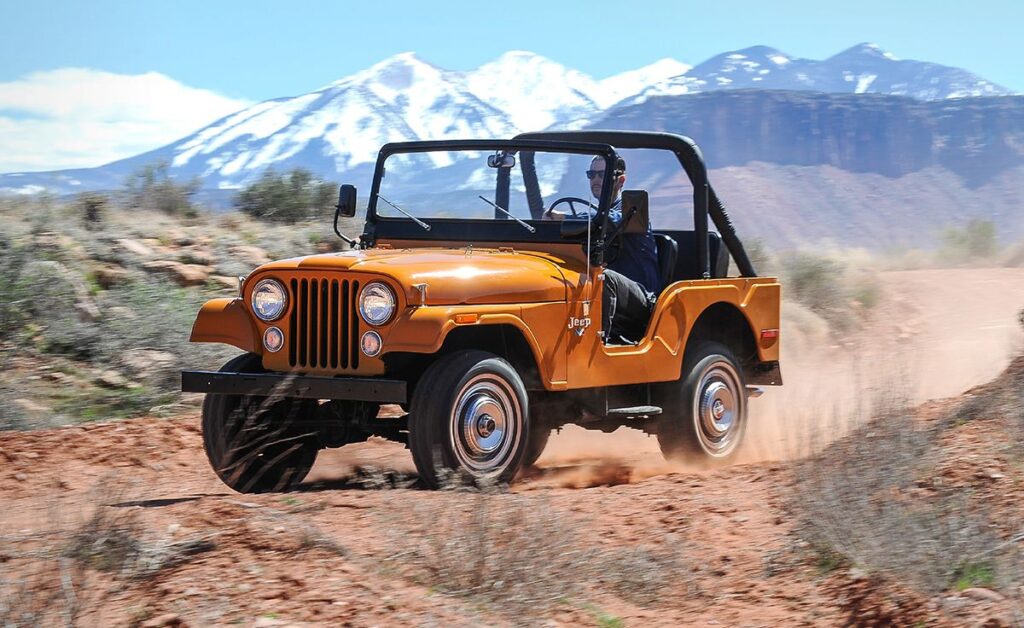
If you need to choose between Jeep CJ5 VS CJ7, we recommend going with CJ7. One of the reasons the Jeep CJ7 is still so highly regarded is because of its incredible durability and its ability to tackle any type of terrain.
This is a classic SUV, based on those used by the US Army during World War II, something that hints at the incredible indestructible capacity of the CJ7.
The main novelty of this model was in its dimensions since the wheelbase grew 10 inches (25.4 centimeters) to 237 centimeters.
Also, the chassis side members were separated at their rear section to allow the leaf springs and shock absorbers to be anchored closer to the wheels, which improved stability.
To this, we must add the fact that it has a not insignificant motorization range, with options for all tastes, in the same way, that it happened with its transmission.
Do not forget that the intention of Jeep with its CJ range was to take military vehicles to the streets.
Conclusion
After Jeep CJ5 Vs CJ7, we can say that the CJ series by Jeep has manufactured several different off-road vehicle models. Jeep CJ5 and Jeep CJ7 are some of the rare models that have changed the trends of the off-road car.
The Jeep CJ5 was produced first in 1954 and it was launched as a compact vehicle that was capable of maneuvering off-road.
Jeep Cj5 was produced in the year 1954. It was introduced as a compact vehicle capable of maneuvering outside the road. The CJ5 Jeep comes with a smaller wheelbase if we compare it with Jeep CJ7.
Jeep CJ7 was launched in 1976 and it was offered a different appearance compared to other Jeep CJ models.
This model was a quite better option for the CJ lovers in terms of great added features. However, it was costlier than other models.
